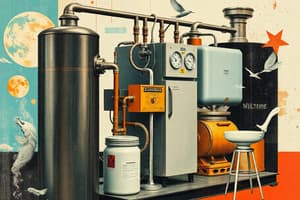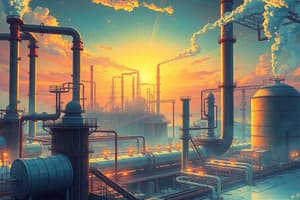Podcast
Questions and Answers
What is the result of moisture present in the refrigeration system?
What is the result of moisture present in the refrigeration system?
- Increased efficiency of the electric motor
- Improved thermal transfer properties
- Formation of ice crystals in the compressor
- Corrosion and sludge formation (correct)
What corrosive compound is formed when ammonia combines with water?
What corrosive compound is formed when ammonia combines with water?
- Ammonium chloride
- Ammonium sulfate
- Ammonium nitrate
- Ammonium hydroxide (correct)
Which material should NEVER be used in ammonia refrigeration systems due to corrosion risk?
Which material should NEVER be used in ammonia refrigeration systems due to corrosion risk?
- Cast iron
- Copper alloys (correct)
- Aluminium
- Stainless steel
In the context of the refrigeration system, what does the term 'sludge' refer to?
In the context of the refrigeration system, what does the term 'sludge' refer to?
What does the compressor in a refrigeration system primarily do?
What does the compressor in a refrigeration system primarily do?
How does compression affect the refrigerant vapour in a refrigeration system?
How does compression affect the refrigerant vapour in a refrigeration system?
Which component in the refrigeration system is responsible for heat transfer from the refrigerant to the coolant?
Which component in the refrigeration system is responsible for heat transfer from the refrigerant to the coolant?
What is the role of the evaporator in a vapour compression refrigeration system?
What is the role of the evaporator in a vapour compression refrigeration system?
What determines the operating pressures and temperatures in a vapour compression refrigeration system?
What determines the operating pressures and temperatures in a vapour compression refrigeration system?
Which of the following is a mandatory component of a refrigeration system?
Which of the following is a mandatory component of a refrigeration system?
What is the purpose of the refrigerant metering device in a refrigeration system?
What is the purpose of the refrigerant metering device in a refrigeration system?
In a refrigeration cycle, the refrigerant returns to which component after condensing in the condenser?
In a refrigeration cycle, the refrigerant returns to which component after condensing in the condenser?
What does the ASHRAE designation for refrigerants include?
What does the ASHRAE designation for refrigerants include?
Which of the following properties does NOT directly affect the movement of heat in refrigerants?
Which of the following properties does NOT directly affect the movement of heat in refrigerants?
Why is no single refrigerant considered ideal for all applications?
Why is no single refrigerant considered ideal for all applications?
At what standard operating conditions is the thermodynamic comparison of refrigerants made?
At what standard operating conditions is the thermodynamic comparison of refrigerants made?
Which of the following refrigerants is mentioned as an example in the context of thermodynamic properties?
Which of the following refrigerants is mentioned as an example in the context of thermodynamic properties?
What is the average temperature of the chilled water in a cooling coil designed for a 10°C temperature difference?
What is the average temperature of the chilled water in a cooling coil designed for a 10°C temperature difference?
At what temperature does the water leave the cooling coil?
At what temperature does the water leave the cooling coil?
What is the lowest operating temperature for the evaporator to remain practical?
What is the lowest operating temperature for the evaporator to remain practical?
What condenser pressure is required to maintain the condensing temperature of 30°C?
What condenser pressure is required to maintain the condensing temperature of 30°C?
How are thermodynamic properties of refrigerants primarily obtained?
How are thermodynamic properties of refrigerants primarily obtained?
What average cooling water temperature is utilized in the condenser design?
What average cooling water temperature is utilized in the condenser design?
What is the primary purpose of refrigerant tables in a refrigeration system?
What is the primary purpose of refrigerant tables in a refrigeration system?
What is the significance of the temperature drop in the condenser design?
What is the significance of the temperature drop in the condenser design?
What is the primary definition of a tonne of refrigeration?
What is the primary definition of a tonne of refrigeration?
How much energy does 1 tonne of refrigeration equate to in kJ/day?
How much energy does 1 tonne of refrigeration equate to in kJ/day?
What is the energy output of 1 tonne of refrigeration in kJ/hour?
What is the energy output of 1 tonne of refrigeration in kJ/hour?
In terms of kW, how is one tonne of refrigeration expressed?
In terms of kW, how is one tonne of refrigeration expressed?
What criteria are used for classifying refrigerants?
What criteria are used for classifying refrigerants?
Why is it important to consistently refer to refrigerants?
Why is it important to consistently refer to refrigerants?
What is the equivalent energy of 1 tonne of refrigeration expressed in kJ/s?
What is the equivalent energy of 1 tonne of refrigeration expressed in kJ/s?
What is the relationship between the latent heat of fusion and the concept of tonnes of refrigeration?
What is the relationship between the latent heat of fusion and the concept of tonnes of refrigeration?
What is the primary issue with using oil-miscible refrigerants in a refrigeration system?
What is the primary issue with using oil-miscible refrigerants in a refrigeration system?
Which refrigerant is known for being non-miscible with lube oil?
Which refrigerant is known for being non-miscible with lube oil?
What effect does oil build-up in the evaporator and condenser have on a refrigeration system?
What effect does oil build-up in the evaporator and condenser have on a refrigeration system?
What is the purpose of oil separators in ammonia refrigeration systems?
What is the purpose of oil separators in ammonia refrigeration systems?
What characteristic of halocarbon refrigerants can make leak detection easier?
What characteristic of halocarbon refrigerants can make leak detection easier?
What challenge can arise from the strong, pungent odour of ammonia in public spaces?
What challenge can arise from the strong, pungent odour of ammonia in public spaces?
Why is sizing of piping important in a refrigeration system utilizing oil-miscible refrigerants?
Why is sizing of piping important in a refrigeration system utilizing oil-miscible refrigerants?
Which refrigerant does CSA B52 code restrict to industrial sites due to its flammability?
Which refrigerant does CSA B52 code restrict to industrial sites due to its flammability?
Flashcards
Cooling Coil Temperature Difference
Cooling Coil Temperature Difference
The difference between the average air temperature and the average chilled water temperature in a cooling coil.
Evaporator Boiling Temperature
Evaporator Boiling Temperature
The temperature at which the refrigerant boils inside the evaporator.
Condenser Condensing Temperature
Condenser Condensing Temperature
The temperature at which the refrigerant condenses inside the condenser.
Evaporator Pressure
Evaporator Pressure
Signup and view all the flashcards
Condenser Pressure
Condenser Pressure
Signup and view all the flashcards
Thermodynamic Properties of Refrigerants
Thermodynamic Properties of Refrigerants
Signup and view all the flashcards
Refrigerant Tables
Refrigerant Tables
Signup and view all the flashcards
Calculating System Performance
Calculating System Performance
Signup and view all the flashcards
ASHRAE Designation
ASHRAE Designation
Signup and view all the flashcards
Thermodynamic Properties
Thermodynamic Properties
Signup and view all the flashcards
Boiling Point
Boiling Point
Signup and view all the flashcards
Refrigerant Differences
Refrigerant Differences
Signup and view all the flashcards
Standard Operating Conditions
Standard Operating Conditions
Signup and view all the flashcards
What is a tonne of refrigeration?
What is a tonne of refrigeration?
Signup and view all the flashcards
What is the standard heat rate of 1 tonne of refrigeration?
What is the standard heat rate of 1 tonne of refrigeration?
Signup and view all the flashcards
How are refrigerants classified?
How are refrigerants classified?
Signup and view all the flashcards
What is flammability in refrigerant classification?
What is flammability in refrigerant classification?
Signup and view all the flashcards
What is toxicity in refrigerant classification?
What is toxicity in refrigerant classification?
Signup and view all the flashcards
How does environmental impact affect refrigerant classification?
How does environmental impact affect refrigerant classification?
Signup and view all the flashcards
How are refrigerants classified based on their chemical origins?
How are refrigerants classified based on their chemical origins?
Signup and view all the flashcards
How is operating temperature suitability used to classify refrigerants?
How is operating temperature suitability used to classify refrigerants?
Signup and view all the flashcards
Compressor in refrigeration systems
Compressor in refrigeration systems
Signup and view all the flashcards
Compression in refrigeration
Compression in refrigeration
Signup and view all the flashcards
Evaporator
Evaporator
Signup and view all the flashcards
Condenser
Condenser
Signup and view all the flashcards
Refrigerant Metering Device
Refrigerant Metering Device
Signup and view all the flashcards
Vapor Compression Refrigeration System
Vapor Compression Refrigeration System
Signup and view all the flashcards
Relationship between temperature and pressure in refrigeration
Relationship between temperature and pressure in refrigeration
Signup and view all the flashcards
Selecting Refrigerant and Operating Parameters
Selecting Refrigerant and Operating Parameters
Signup and view all the flashcards
Vapor Compression Refrigeration Cycle
Vapor Compression Refrigeration Cycle
Signup and view all the flashcards
Coefficient of Performance (COP)
Coefficient of Performance (COP)
Signup and view all the flashcards
Pressure Ratio
Pressure Ratio
Signup and view all the flashcards
Refrigerants
Refrigerants
Signup and view all the flashcards
Refrigerant Miscibility
Refrigerant Miscibility
Signup and view all the flashcards
Oil-Miscible Refrigerants
Oil-Miscible Refrigerants
Signup and view all the flashcards
Non-Miscible Refrigerants
Non-Miscible Refrigerants
Signup and view all the flashcards
Oil Separator
Oil Separator
Signup and view all the flashcards
Oil Return System
Oil Return System
Signup and view all the flashcards
Ammonia Smell & Panic
Ammonia Smell & Panic
Signup and view all the flashcards
Halocarbon Refrigerant Odor
Halocarbon Refrigerant Odor
Signup and view all the flashcards
Flammable Refrigerants & Restrictions
Flammable Refrigerants & Restrictions
Signup and view all the flashcards
Study Notes
Learning Outcomes and Objectives
- Students will be able to explain the basic concept of refrigeration and refrigerants.
- Objectives include explaining fundamental refrigeration, describing vapour compression refrigeration system operation cycles, and explaining operating temperatures and pressures.
- Refrigerant classification and thermodynamic properties will also be covered, along with refrigerant properties related to miscibility, leak tendency, odour, moisture reaction, toxicity, and flammability.
Chapter Introduction
- Refrigeration is defined as the process of moving heat from one location to another to reduce and maintain the temperature of a material below its surroundings.
- Refrigeration relies on the circulation of refrigerant in a closed cycle.
Objective 1: Fundamentals of Refrigeration
- The first principle of refrigeration is the concept of latent heat removal.
- Evaporation of a liquid absorbs heat, leading to a cooling effect.
- Pressure affects the boiling point of a liquid. Higher pressure leads to a higher boiling temperature.
Objective 2: Vapour Compression Refrigeration System Cycle
- Actual refrigeration systems use additional components for continuous operation.
- A liquid receiver provides continuous refrigerant supply to the evaporator.
- A metering device controls refrigerant flow rate to the evaporator.
- Refrigerant vapour leaves the evaporator and is compressed.
- The vapour is cooled in a condenser, changing it back to a liquid.
- The liquefied refrigerant returns to the receiver, completing the cycle.
- A compressor is needed to raise the vapour temperature and pressure.
Objective 3: Operating Temperatures and Pressures
- Operating temperatures and pressures are determined by the desired cooling effect.
- System components are designed for the specific temperature/pressure ranges.
- Proper equipment selection is based on refrigerant properties and operating conditions.
Objective 4: Refrigeration System Capacity
- Capacity is measured in tonnes of refrigeration (TR).
- One TR is the amount of heat required to produce one tonne of ice at 0°C from water at 0°C in one day.
- Conversion between SI and USCS units of refrigeration capacity is readily available.
Objective 5: Refrigerant Classification
- Refrigerants are categorized by their flammability, toxicity, and environmental impact.
- Common refrigerants are identified by ASHRAE designations.
Objective 6: Thermodynamic Properties of Refrigerants
- Refrigerant properties include pressure, temperature, volume, density, enthalpy, and entropy.
- These properties are tabulated in refrigerant tables and charts for various refrigerants.
- These properties are used for calculations related to refrigeration cycles and performance.
Physical Properties of Refrigerants - (OBJECTIVE 7)
- Properties include miscibility (solubility with lubricants), leakage tendency, odour, moisture reaction, toxicity, and flammability.
- Refrigerant choice often involves tradeoffs and compromises.
Studying That Suits You
Use AI to generate personalized quizzes and flashcards to suit your learning preferences.





